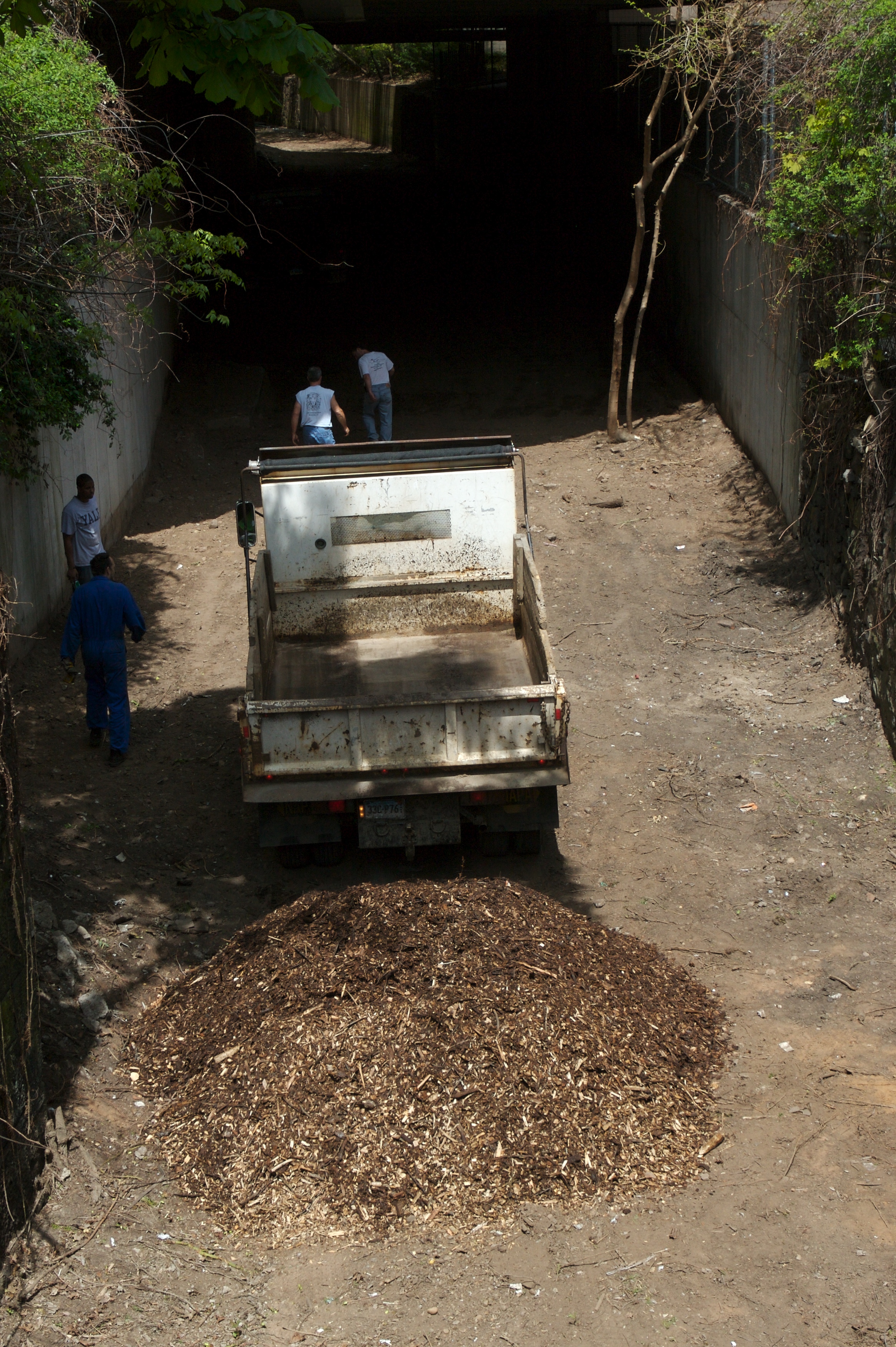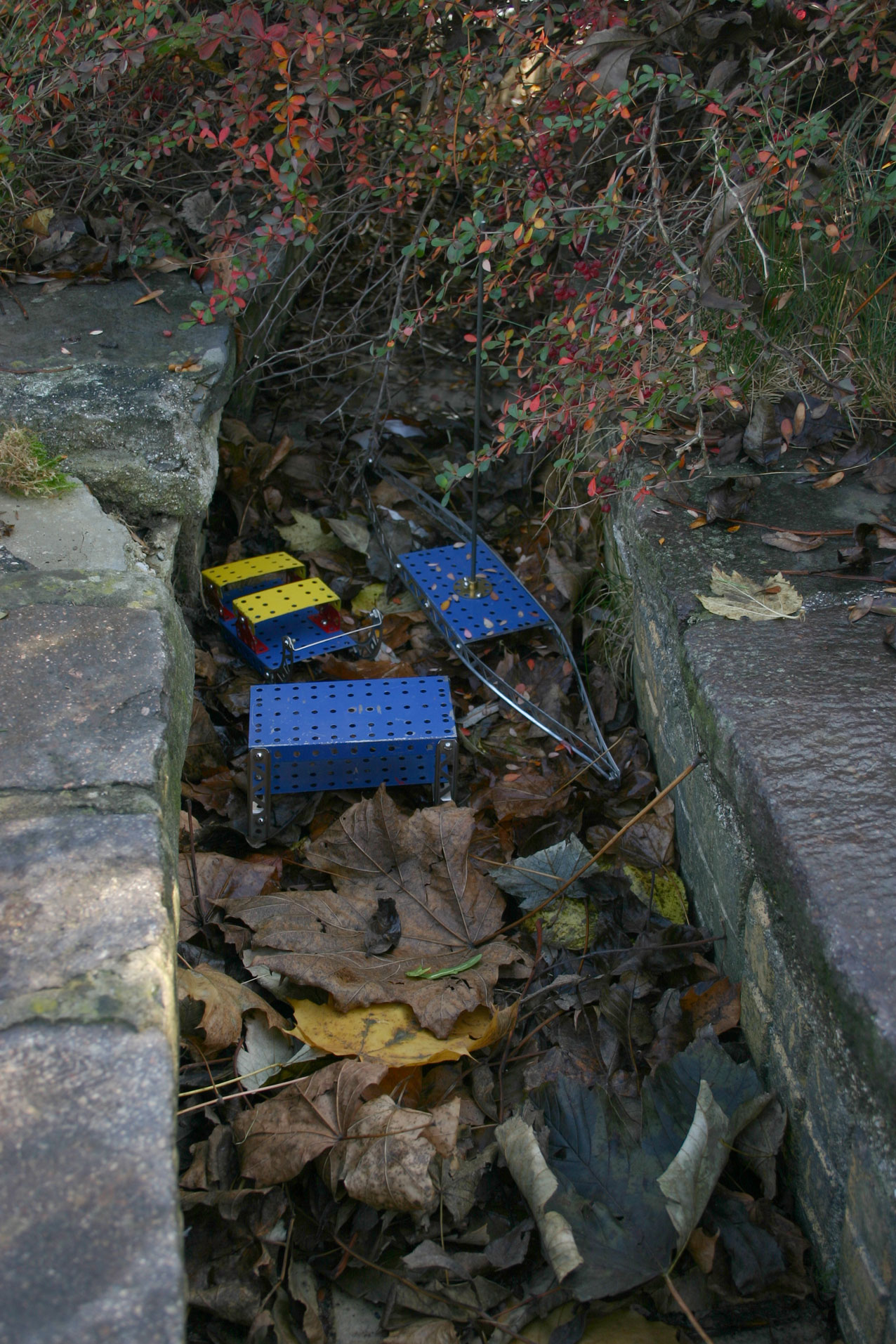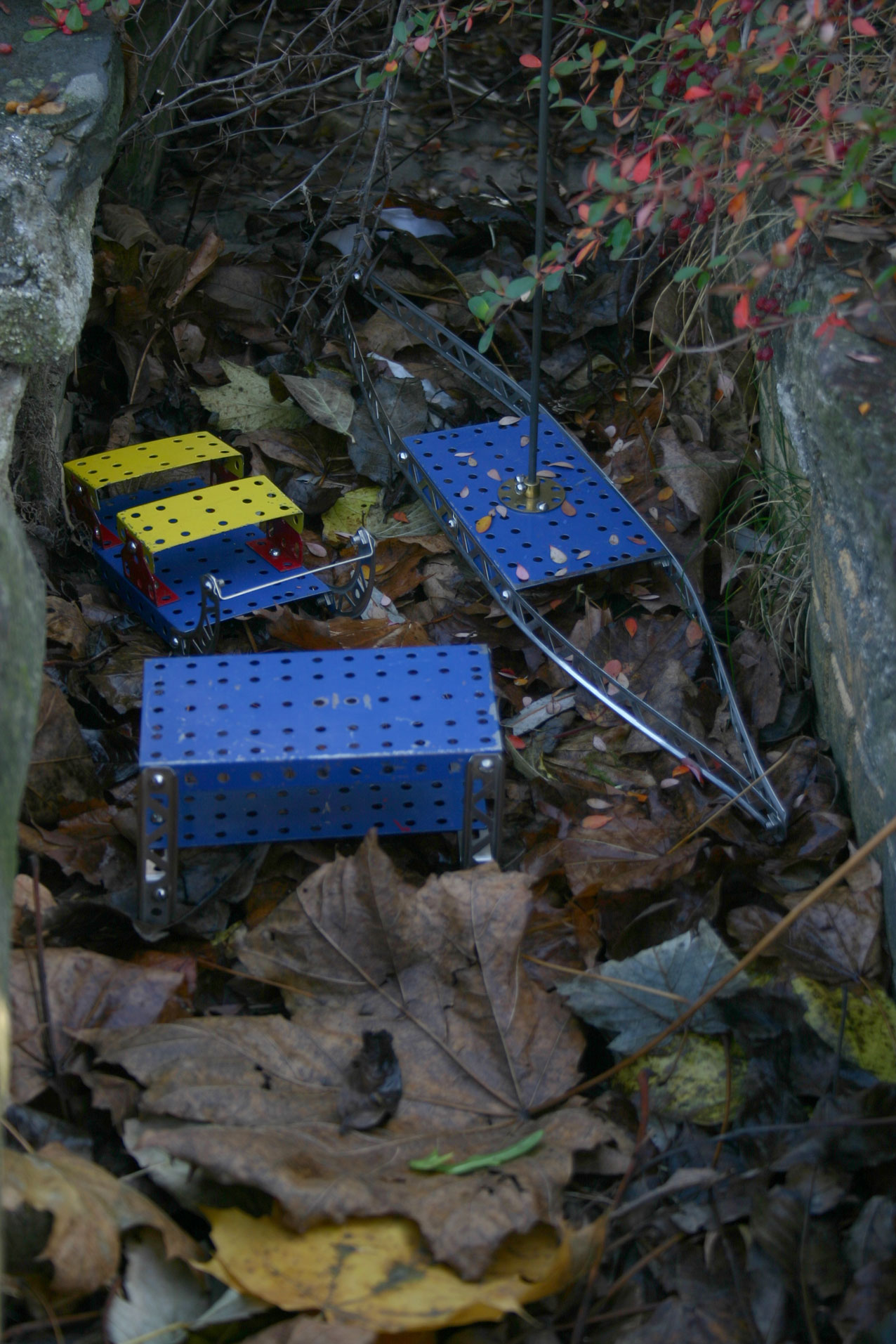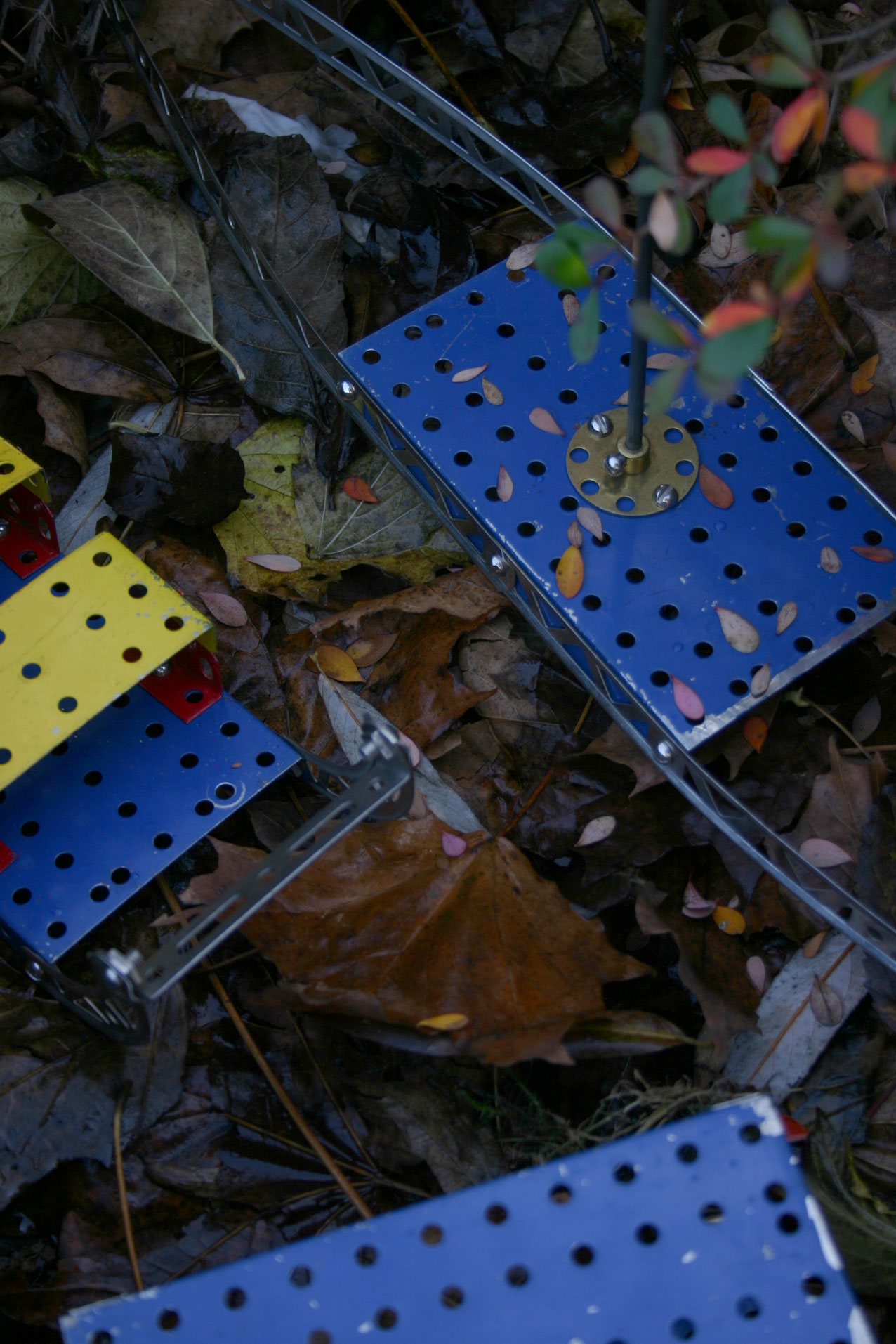“About the Installation”
When Slovenian artist Matej Vogrincic first visited New Haven at the invitation of Site Projects, it was the abandoned, depressed Farmington Canal cut in the middle of the city’s busy legal/financial center and award-winning arts district that caught his attention. Opened for commercial traffic in 1828, the Farmington Canal failed to produce the expected revenues and was soon converted to an industrial rail line, remaining active into the 1960’s. Although many sections of this right-of-way between New Haven and Northampton, MA have been converted to a popular linear park, the renovation of this final section had yet to be undertaken. untitled (this used to be my playground) began the restoration efforts of the last overgrown section of the Farmington Canal. Residents -- both young and old -- volunteered to assist Site Projects in its efforts to clean the canal.
While in New Haven, Vogrincic also visited the Eli Whitney Museum and learned of another icon of New Haven and America’s industrial heritage: the Erector Set. New Haven’s A.C. Gilbert Company manufactured these nationally renowned metal toy construction kits throughout most of the 20th Century.
Inspired by the history of these nationally-loved toys and the mysterious quality of the abandoned canal, Vogrincic had identified the tools and the place to create a striking site-specific, temporary work of art. Vogrincic created enormous steel boats reminiscent of these beloved classic toys and filled them with the building blocks of the city: brick, crushed trap rock and oyster shells. Audio tours by local historians and scholars were recorded and could be accessed through one’s cellphone. Class visits were given during the International Festival. The installation remained on view for 4 months when the materials were given to the Common Ground High School who came to the site and gathered the brick and steel pieces to use in landscaping. This was Vogrnicic’s first large-scale installation in the United States.
“Media”

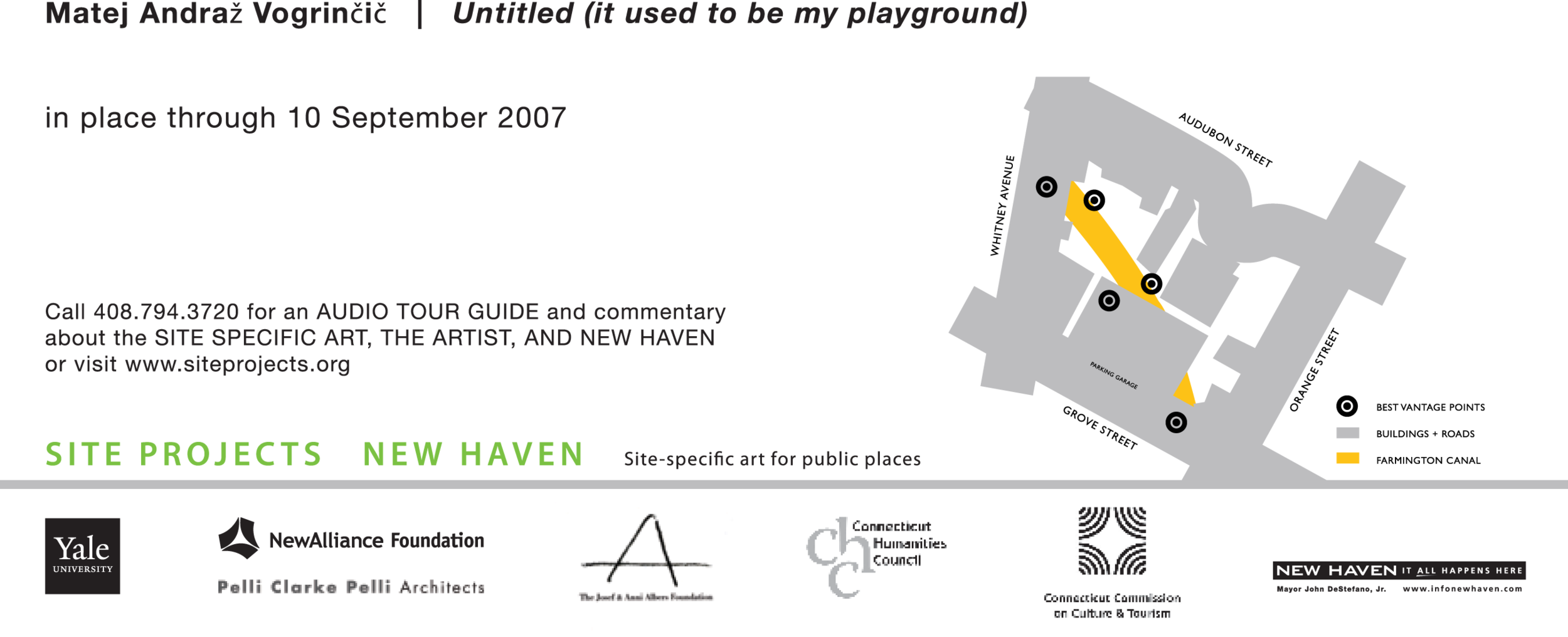
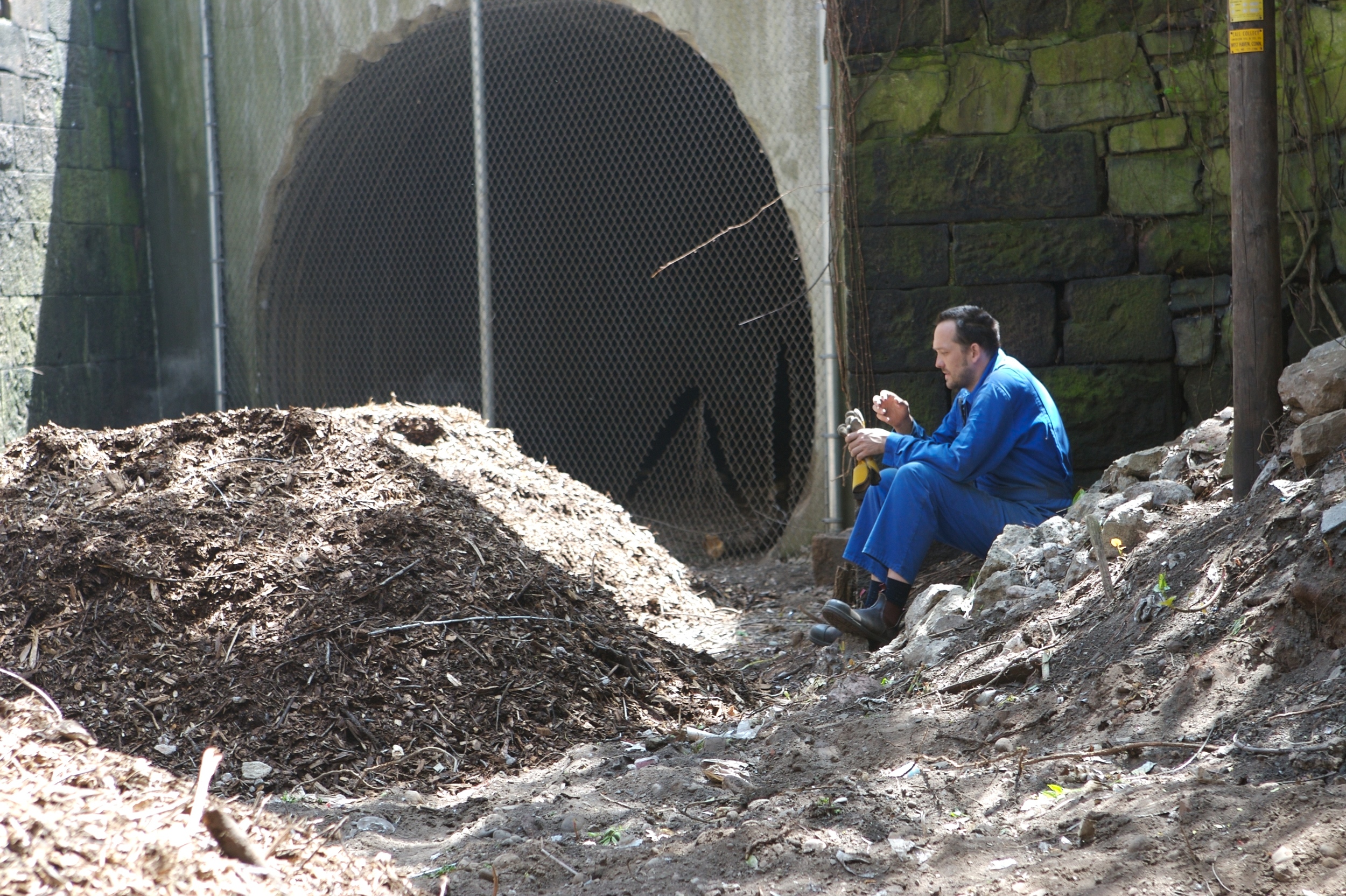
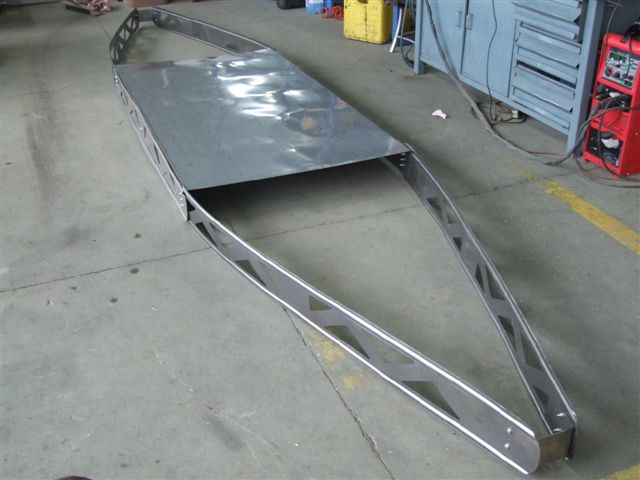


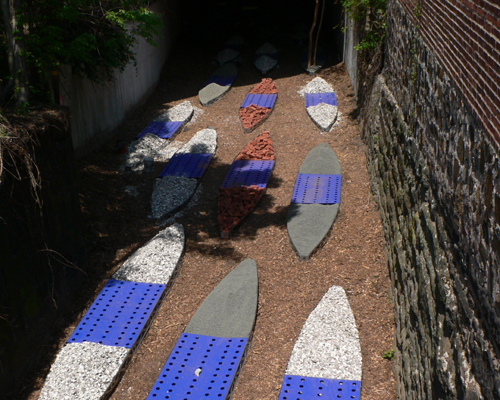
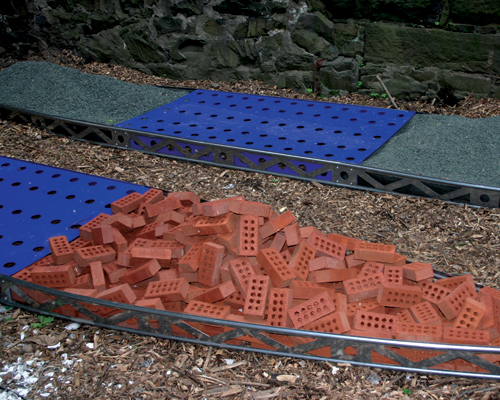
“About the Artist”
MATEJ ANDRAŽ VOGRINČIČ (b. October 12, 1970, Ljubljana, Slovenia) has been creating site-specific work in urban and natural environments since the early 1990s. He has built an international reputation by creating installations specific to local places, traditions, and histories – filling the most ordinary or neglected places with even more ordinary objects. With all his work, Vogrincic starts with the space but always leaves room to alter and develop the idea in the process. He regularly relies upon a direct connection with the local community to help him create his projects, including clothing and toy car donations.
Vogrinčič first “dressed” a dilapidated house with donated clothing in his hometown and then presented a similar project at the Venice Biennale in 1999. He created the project “Car Park: Members Only” – a wall installation consisting of 15,000 toy cars placed on a wall of a building in Australia’s Adelaide in response to the city’s traffic and parking problems and continued to the Australian outback, where he put up a watering can installation, consisting of some 2,000 plaster watering cans arranged over the area of a football field in a region largely devoid of rain. As part of the 2003 Awesome Festival in Australia’s Perth, he filled up an area of 7,000 square meters with 10,000 balloons of red, orange, blue, pink, green and yellow colors. He filled the atrium of the former Melbourne GPO with 1000 umbrellas in 2005. His most recent exhibition, commissioned for the 4th Liverpool Biennial in England and featured in The Guardian newspaper andLIFE magazine, was an installation of 56 upturned boats placed inside the bombed ruins of the Gothic Era St. Luke’s Church.
Other works from the Artist
Projects in Public Spaces
2006 St. Luke’s Church, Liverpool, England
2005 When on a Winter’s Night a Traveller, GPO Melbourne, Melbourne, Australia
2004 Untitled (Forest), Ljubljana, Slovenia
2003 Beach Balls, Perth, Australia
2002 Moon Plain, Coober Pedy, Australia
Port, Christchurch, New Zealand
Car Park: Members Only, Adelaide, Australia
1999 Dressed House, Venice, Italy
1997 Street Wear, Ljubljana, Slovenia
1993 House, Ljubljana, Slovenia
Selected Solo Exhibitions
2003 Moon Plain, Museum of Modern Art, Ljubljana, Slovenia
2002 Moon Plain, SOFA Gallery, Christchurch, New Zealand
1999 Clothes Sculpture, John Gibson Gallery, New York, USA
1996 Dressing, Anonimus Galllery, Ljubljana, Slovenia
1992 Ready Made, SKUC Gallery, Ljubljana, Slovenia
Selected Group Exhibitions
2005Slovene Art 1995–2005: Territories, Identities, Nets, Museum of Modern Art, Ljubljana, Slovenia
The First Line, 26th Biennale of Graphic Arts, Ljubljana, Slovenia
2004 Slovene Art 1985–1995, Museum of Modern Art, Ljubljana, Slovenia
2002 Art+Industry Biennial, Christchurch, New Zealand
Tancat per Obres (Artists in Architecture) Collegi d’Arquitectes de Catalunya,
Barcelona, Spain
1997 U3, Triennial of Slovene Contemporary Art, Museum of Modern Art, Ljubljana, Slovenia
This Art is Recycled, SKUC Gallery, Ljubljana, Slovenia
1996 Urbanaria, SCCA, Ljubljana, Slovenia
“Educational Resources + Commentary”
Audio EssayS
+ The Trumble Diaries: Matej Andraž Vogrinčič by Senior Curator of Paintings and Sculpture at the Yale Center for British Art Angus Trumble
What is this work of art? Is it a very large sculpture, a piece of landscape architecture, or civic design? Is it an event, a memory, a 3-dimensional visual poem, or simply a place?
In the short-hand jargon of the current contemporary art world, the work of Slovenian artist, Matej Andraž Vogrinčič is usually called ‘site specific’ or ‘installation’ art. This has developed out of a remarkable transformation in the range and type of locations that artists sought out in the past 50 years. American ‘earthworks’ or ‘land art’ of the 1960s, for example, is one of the most striking of those recent movements. In common with many other kinds of large-scale ‘installation’, these projects, which were sometimes even created for places where few if any people might actually see them, defied the conventions of the modern art market that have arisen over the past 300 years. It is often impossible to ‘own’ an installation, to collect it, or to corral it into a larger collection of art by other people. It insists upon its own autonomy, and frequently takes advantage of unique features of the surroundings, whether it is a stretch of open country or a disused urban space. And the artist asserts his right to shape and determine every aspect of our experience of the work of art. It can never exist in quite the same way anywhere else, or at any other time, except in our memories.
Matej Andraž Vogrinčič has created installations in Ljubljana, the capital City of his native country, Slovenia, as well as in Venice, Italy; Adelaide, South Australia; the isolated opal-mining community of Coober Pedy in the desert of far outback Central Australia; Perth, Western Australia; Christchurch, New Zealand, Liverpool in the north of England, and elsewhere. This installation in New Haven is his first work in the United States.
In each case, Matej Andraz takes advantage of the unique environment in which he works, often alluding to the history of the place, bringing to the task not merely hard physical work, but wry wit, and a no-nonsense, non-argumentative accommodation of the concerns of local people, the requirements of the civic authorities, even the weather. One of the most important features of his work is its capacity to interest and stimulate children, and while his works range widely in format, they have in common a basic clarity in the choice of simple motifs with local resonance, and a capacity to harness those motifs with intelligence, and gentle humor.
This text was drafted for public information by a private group of individuals in New Haven, who made possible Matej’s recent, 2007 Farmington Canal ‘Erector Set’ project, part of which is illustrated above. The text, which was aimed at the general public, was used by the group in various ways along with an interview I videotaped with Matej.
+ A.C. Gilbert & Memory by William Brown, Eli Whitney Museum
Imagine you are talking to your grandfather about the year when he was your age. Ask him: when you think of New Haven back then, what image comes into your mind? Very likely he will say: I see the bright red steel box of an A.C. Gilbert Erector Set. I see nuts and bolts and girders; I see an electric motor and magnet.
That box was a treasure chest. It was the most famous building toy in the world. All the years that America built its great bridges, and railroads, and skyscrapers, Erector Sets taught young engineers to build and dream. And New Haven built Erector Sets.
The Erector Set was invented by A.C. Gilbert, who came to New Haven in 1904 from all the way across America to study medicine at Yale, to star as an athlete, and to perform magic for audiences in local vaudeville theaters, where before television, movies and radio, people were entertained with music and magic shows. Gilbert loved to perform. He also designed and sold magic tricks and he did it with such success that he never got round to practicing medicine.
One day in 1913 when Gilbert was traveling to his Magic store in New York City on the New Haven Railroad he saw construction everywhere. Electric towers along the tracks would allow new trains to travel underground to a Grand Central Station without the hazardous smoke of the old steam locomotives. Gilbert realized that those steel lattices, girders and the electricity they carried would change everything, and that they could also be made to work on any scale. The result was the miniature construction empire in a box that would make New Haven famous.
Gilbert’s factory and fame grew quickly. He was a gifted salesman. He promised parents that his construction sets were an investment in their child’s future. In 1920, when it became possible to speak on radio waves, he built Connecticut’s first broadcast station and pioneered a whole new way to talk to his customers. His radio tower was a landmark for his Fair Haven factory and for New Haven.
Why is this memory so powerful? An Erector Set was the king of toys when no one had many toys. At it peak, 3000 people worked in Gilbert’s Fair Haven factory. They were proud to be producing an icon of invention. But most important, Gilbert built a powerful message into the parts and tools he shipped round the world. Each Erector Set said: I believe you can teach yourself to solve any problem. It was a message, broadcast from New Haven, that inspired three generations.
William Brown is Director of the Eli Whitney Museum in Hamden, CT and a noted A.C. Gilbert scholar. He is author of The Gilbert Epoch, in Essays in Arts and Sciences, Vol. XXV (University of New Haven, 1996). He has produced exhibitions on Eli Whitney, A.C. Gilbert and Leonardo daVinci that explore the balance between classroom and workshop learning. Under his direction the Museum's experimental building workshops have grown to produce 72,000 learning projects a year. His work has been recognized by two honorary degrees.
+ A Short History of the Farmington Canal by the New Haven Museum and Historical Society
A canal is a man-made waterway used primarily as a passage for boats and ships where there were no navigable rivers. Canals have been used since ancient times but only grew popular in Europe in the 17th and 18th centuries. In the New World as people began moving inland, it was important to find new ways to ship food and wood out of rural areas into the cities, and ship much-needed supplies back.
In the 1820s people felt that New Haven, with its busy harbor, should have a canal to connect it to towns further inland. Many New Haven residents were excited about the prospect of linking New Haven to Massachusetts with the canal to be named for the source of its water, the Farmington River. As with highway construction today, the excitement wasn't shared by everyone, but the project began in 1822.
The biggest problem facing the builders of the canal was getting the money to pay for it, which took over 2 years. Finally, on the 4th of July, 1825, a ground breaking ceremony was held in Salmon Brook, Connecticut, and the work got under way.
Canal construction in America faced many problems. The first canal builders in America were amateurs, and they made many mistakes. The Farmington Canal was also not built by one company, but was contracted out to local companies, each working on separate sections. These companies usually hired family and friends to do the digging, but when this didn’t supply them with enough workers, they hired free African Americans and Irish immigrants.
In 1825, without mechanical equipment, digging the canal was very hard work. Laborers used axes, shovels and wheelbarrows to move the trees and dirt. They worked all day long, for a dollar a day, and then walked home.
The canal was opened in 1828 but it was not a financial success. The money collected from tolls and other fees was barely enough to pay for its maintenance. However, not long after the canal was built, railroad companies began looking for a place to lay railroad tracks and the canal pathway was an attractive possibility. In 1846, speculators got permission to replace the canal with a railway line. Trains ran along the old canal path from 1848 until the twentieth century, when the path was converted into trails for public use.
Amy Trout is Curator of the New Haven Museum and Historical Society (where she curated the 1995 exhibit on the Farmington Canal), and is the author of The Story of the Farmington Canal (The New Haven Colony & Historical Society, 1995). This essay was excerpted from Ms. Trout’s book by Benjamin Breton, Museum Teacher at the New Haven Museum and Historical Society.
+ The Farmington Canal in the Urban Landscape by Alan J. Plattus, Professor of Architecture, Yale University
At more than 350 years old and counting – not to mention its history before European settlement – the city of New Haven is old by North American standards and exceptionally rich in layers of physical history.
In the center of New Haven there is the strong and clear pattern of the nine-square grid of streets laid down in 1638 by its founders -- inspired by the Bible and descriptions of the geometrically ordered Temple of Solomon in Jerusalem. This regular grid provides a framework against which earlier and later features can be read. Among the more dramatic of those later features is the bold diagonal gash across the eastern corner of the nine squares: the path of the Farmington Canal. The Canal originally terminated in the Canal Basin in New Haven's harbor. From there it ran north over 80 miles to join the Connecticut River at Northampton, Massachusetts. Like the old turnpikes connecting the city to neighboring settlements, the Canal was part of a radial system spreading out from the tightly ordered center and reaching into the surrounding countryside.
Laid out in 1825 as an ambitious effort to re-situate New Haven economically and geographically, the Farmington Canal functioned as an active means of water-based transport for barely twenty years, but it has had a long and fascinating afterlife -- converted first to an important rail corridor, then largely abandoned and most recently, as a piece of a growing network of local, regional and national trails that may eventually connect the entire east coast for bicyclists and pedestrians.
And yet, even today its obvious links to the past are still fascinating. It’s an excavation into New Haven’s history. While there is little along its route dating to the1820’s, it provides a vantage point on the changing city and reveals traces of almost every subsequent era of New Haven history, as well as a good deal of environmental history. The portion of the old canal corridor in the heart of New Haven, between Prospect and State Streets, is literally an archaeological excavation. At the Whitney Avenue crossing one looks up to the old McLagon Foundry building, from the 1870’s, a reminder of how the Canal and the subsequent railway were a conduit for industrial development from the center of the city to the sprawling Winchester Repeating Arms factory (now Science Park) in Newhallville. And at Grove Street one can see a veritable cross-section of historic masonry buttressing the walls of the corridor.
In its new role as a piece of recycled industrial history the canal returns in certain respects to its origins. Much as it played its role in the rise of urban areas as industrial centers served by canals and railroads, it is now a harbinger of a new age for New Haven and American cities as social, cultural and recreational centers. In this city the canal corridor continues to derive its meaning from its unique difference –its difference of level, of orientation, of scale and of pace – raising questions and continuing possibilities for exploration and discovery.
+ Water to Rails: Industrial Growth in New Haven *by Professor Douglas Rae, Yale University School of Management*
In 1800, when the U.S.A. was still a teen-aged nation, shipping things like food and lumber was slow and costly. For example, shipping the oats for your morning porridge took as long and cost as much as it had when people like Julius Caesar or Queen Boadicea were impatiently waiting to eat breakfast. This meant that almost everything people used—the things they ate, wore, or built with-- had to be produced within about 20 miles of their homes. Only things that were small and very high priced, like jewelry, spices, or coins could be transported over long distances at costs that made sense – and even then the prices of such things made sense only to the rich.
When the Farmington Canal was completed, it became possible to ship heavy items to New Haven cheaper and faster than had been possible before. By 1830, four million pounds of goods were shipped between New Haven and Northampton, Massachusetts, and the 75-mile trip could be covered in just one day. It was one of a number of canals constructed to improve America’s links to its developing interior, like the much larger Erie Canal, from Albany to Buffalo in New York State, which in 1825 connected the east coast to farm country in places like Iowa, Illinois, Indiana, and Ohio. Breakfast got better and cheaper because the ingredients were produced in the right places.
But the canals were just a temporary fix. Railroad trains were being pioneered even before the Farmington and Erie canals were dug, and their roll-out in the 1840s was the real revolution. For the first time ever in human history, you could ship breakfast at 50 miles an hour – faster than five times the speed of any canal boat. Heavy and bulky things – corn, oats, lumber, sugar cane, steel bars – could travel from Chicago to New Haven in just a day or so, and could do it cheaply.
However, these canals were obsolete just two decades after they were built. By 1847, the Farmington Canal was drained. Wooden ties and steel rails were laid down and in 1848, the New Haven & Northampton Railroad was up and running along the canal pathway. Even more important, the New York and New Haven Railroad started business the same year, and once New Haven was connected to New York, it was connected to the world!
Smart people made it a center for the manufacture of many of the things the world wanted most. For example, by the 1850s Chauncey Jerome was making the world's best cheap clocks and shipping them all over the USA and even to Europe and Asia. Winchester was making the best rifles in the world and shipping them to the four corners of the globe.
Douglas W. Rae is Ely Professor of Organization and Management at the Yale School of Management. A fellow of the American Academy of Arts and Sciences and a former Guggenheim Fellow, Professor Rae is frequently consulted by the media for his views on urban development, reversing urban poverty, and regionalization. His latest book, City: Urbanism and Its End, was published in 2003 by Yale University Press.
“Sponsors, Donors & Supporters”
Vogrincic/New Haven: Art in the Canal is made possible through grants, donations, and support from:
Lead Sponsors
ABC Pomurka International
The Josef and Anni Albers Foundation
The Connecticut Humanities Council
Ministry of Culture, Republic of Slovenia
NewAlliance Foundation
City of New Haven–Liveable City Initiative; Department of
Parks, Recreation and Trees; City Plan Department
Greater New Haven Convention and Visitors Bureau
Yale University–Office of New Haven and State Affairs; Office of the Deputy Provost for the Arts; Yale Facilities; Yale Security
Fred and Laura Clarke
Jerome and Roslyn Meyer
Sponsors
Bank of America
Bob Bloom–nrb3 / Bloom Brothers
Peter Chapman–La Saraghina
Cheshire Endocrinology & Internal Medicine
Eric Epstein–Epstein Design Associates
Daniel Fine–Bagel Fish Productions
Grove Parking Associates
Konover Office & Commercial Corporation
Konover Properties Corporation
Ethel & Abe Lapides Foundation
Gary Lyon–Lyon Construction
Nikko America
Chris Ozyck–Alfresco Landscape and Design
Pelli Clarke Pelli Architects
Dean Sakamoto Architects
Len Suzio–Suzio York Hill Companies
Jack and Betsey Dunham
Betsy Henley Cohn
Ruth Lapides
Kenley Lawton
Henry Lord
David and Deborah Moore
Susan and Steven Smith
Contributors
Amity Wine & Spirit Company
William Brown–Eli Whitney Museum
Jack Design
Thomas F. Harberg & Associates
Kennedy & Perkins Guild Opticians
Koffee on Audubon
Maresca & Associates
Chris Naumann–Chris Naumann Landscaping
New Haven Museum & Historical Society
Pot-au-Pho
Schwartz & Hofflich
Sitar Restaurant
Town Green Special Services District
Triola Productions
A. Defne Veral Interiors
Walker Solutions
Linda Briggs
Jay and Grace Bright
Anne and Guido Calabresi
Jennifer Davies
Birgitta Johnson
Charles and Gretchen Kingsley
Aidan Moran
Elisabet Orville
Susan Papa and David Schatz
Charles Pillsbury
Alan Plattus
Sarah Prown and John Coleman
Douglas Rae
David Reynolds
Judy Sirota Rosenthal
Mary Dean Solomon
Michael Vollmar and Paulette Rosen
George Zdru
Friends
Arts Council of Greater New Haven
Creative Arts Workshop
Sam Gougsa–LAZ Parking
Barbara Lamb–City of New Haven, Office of Cultural Affairs
Neighborhood Music School
Nick Seaver–Branford College
Bill Adinolfi
Raymond Allen
Carmine Amento
David Barone
Sam Clarke
Dominick Coppola
Leila Crockett
Win Davis
Mat DiGiovanna
Susan Farricielli
Vassiliki Giannopoulos
Christy Hass
Gary Hogan
Carlos Hortas
Stephen Kobasa
Michael Moran
Mark Morazes
Nicholas Rock
Kai Sakamoto
Naomi Sakamoto
Martha Savage
Sam Shevelkin
Will Solomon
P.J. Vessicchio
Joseph Vitali


